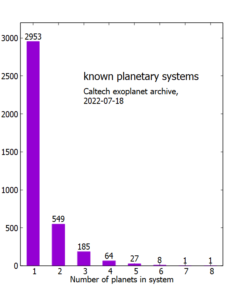by Ludwig Scheibe & Tanja Schumann (TU Berlin), September 2022

Artist’s impression of the planetary system we know by far the most about: Our Solar System. Credit: NASA/JPL
The planets of our Solar System are ordered a certain way: closest to the sun are the smaller, terrestrial planets Mercury, Venus, Earth and Mars, then we have the massive gas giants Jupiter and Saturn, and furthest away from the Sun we have the intermediate-sized ice giants Uranus and Neptune. Additionally, most planets’ orbits are almost circular (so-called “low eccentricity”), and their orbital planes are more or less the same so that the solar system seems to be arranged in a large disk (so-called “low-inclination”).
However, since we began exploring other planets, we found a lot of deviations for what we thought the norm was (based on our Solar System). There are a lot of systems with Jupiter-sized or bigger planets incredibly close to their stars, like 51 Pegasi b, or systems where rocky planets and gas giants are not separated but mixed. There are planets whose orbit, rather than being circular, form an extremely elongated ellipse, such as HD 20782 b. There are also systems, where the planets’ orbital planes do not form a disc as in our Solar System, but where the orbits are significantly inclined to each other, as is the case with HD 39091.
To understand this vast diversity of planetary systems is one of the most important goals of exoplanet research.
Multiple systems
Of the about 5000 known exoplanets discovered as of July 2022, about 2000 are part of planetary systems with more than one confirmed planet around the same star. Most of those are two-planet systems (about 500).

Distribution of known exoplanetary systems, over the number of planets in that system. Data source: NASA exoplanet archive.
However, there is one system with seven known exoplanets: TRAPPIST-1. Its planets, discovered in 2016 and 2017, range between 0.3 and 1.4 times the mass of Earth, which means they are all rocky planets. All of them complete their orbit in less than 20 days and have an orbital radius less than one fifth of that of Mercury, the innermost planet of our Solar System. But because TRAPPIST-1 is an M-dwarf star, and as such is quite a bit less hot than our Sun, three of its planets lie in the star’s habitable zone, i.e. the range around the star where the existence of liquid water on the surface might be possible.

The TRAPPIST-1 system in comparison to the inner Solar System. Green area denotes the habitable zone, which contains TRAPPIST-1 e, f, and g. Credit: NASA/JPL-Caltech
The planets of the TRAPPIST-1 system are very close to orbital resonances with their respective neighbours, meaning in the time it takes one planet to complete a whole number of orbits, their closest neighbour also completes a whole number of orbits.

